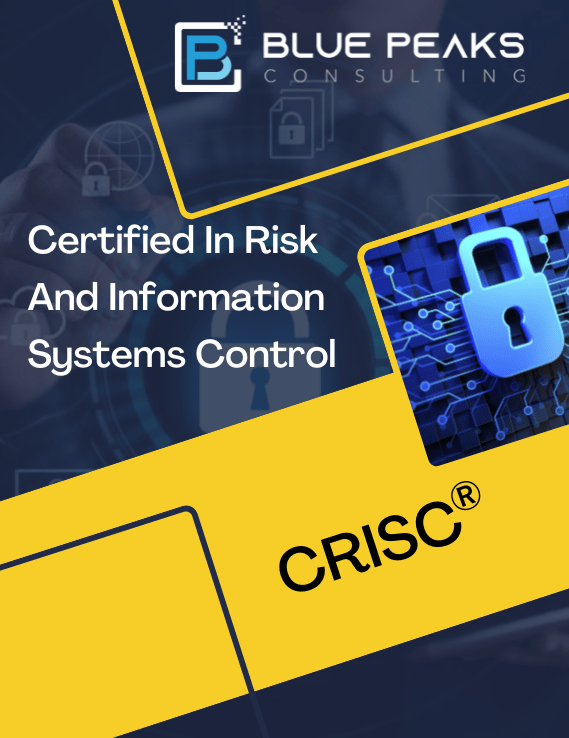Certified in Risk and Information Systems Control (CRISC®)
Certified in Risk and Information Systems Control (CRISC®)
$948
GOALS & OBJECTIVES
Whether you are seeking a new career
opportunity or striving to grow within your
current organization, a CRISC certification
proves your expertise in these work-related
domains:
- IT RISK IDENTIFICATION
- IT RISK ASSESSMENT
- RISK RESPONSE AND MITIGATION
- RISK AND CONTROL MONITORING AND
REPORTING
Description
Domain 1—IT Risk Identification – (27%)
- 1.1 Collect and review information, including existing documentation,
regarding the organization’s internal and external business and IT
environments to identify potential or realized impacts of IT risk to the
organization’s business objectives and operations. - 1.2 Identify potential threats and vulnerabilities to the organization’s
people, processes, and technology to enable IT to risk analysis. - 1.3 Develop a comprehensive set of IT risk scenarios based on
available information to determine the potential impact on business
objectives and operations. - 1.4 Identify key stakeholders for IT risk scenarios to help establish
accountability. - 1.5 Establish an IT risk register to help ensure that identified IT risk
scenarios are accounted for and incorporated into the enterprise-wide
risk profile. - 1.6 Identify risk appetite and tolerance defined by senior leadership and
key stakeholders to ensure alignment with business objectives. - 1.7 Collaborate in the development of a risk awareness program and
conduct training to ensure that stakeholders understand risk and to
promote a risk-aware culture.
Domain 2—IT Risk Assessment – (28%)
- 2.1 Analyze risk scenarios based on organizational criteria (e.g.,
organizational structure, policies, standards, technology, architecture,
controls) to determine the likelihood and impact of an identified risk. - 2.2 Identify the current state of existing controls and evaluate their
effectiveness for IT risk mitigation. - 2.3 Review the results of risk and control analysis to assess any gaps
between the current and desired states of the IT risk environment. - 2.4 Ensure that risk ownership is assigned at the appropriate level to
establish clear lines of accountability. - 2.5 Communicate the results of risk assessments to senior
management and appropriate stakeholders to enable risk-based
decision making. - 2.6 Update the risk register with the results of the risk assessment.
Domain 3—Risk Response Mitigation – (23%)
- 3.1 Consult with risk owners to select and align recommended responses to business objectives and enable informed risk decisions.
- 3.2 Consult with, or assist, risk owners on the development of risk
action plans to ensure that plans include key elements (e.g., response,
cost, target date). - 3.3 Consult on the design and implementation or adjustment of
mitigating controls to ensure the risk is managed to an acceptable
level. - 3.4 Ensure that control ownership is assigned to establish clear lines of
accountability. - 3.5 Assist control owners in developing control procedures and
documentation to enable efficient and effective control execution. - 3.6 Update the risk register to reflect changes in risk and
management’s risk response. - 3.7 Validate that risk responses have been executed according to the
risk action plans.
Domain 4—Risk and Control Monitoring and Reporting –
(22%)
- 4.1 Define and establish key risk indicators (KRIs) and thresholds
based on available data, to enable monitoring of changes in risk. - 4.2 Monitor and analyze key risk indicators (KRIs) to identify changes or
trends in the IT risk profile. - 4.3 Report on changes or trends related to the IT risk profile to assist
management and relevant stakeholders in decision-making. - 4.4 Facilitate the identification of metrics and key performance
indicators (KPIs) to enable the measurement of control performance. - 4.5 Monitor and analyze key performance indicators (KPIs) to identify
changes or trends related to the control environment and determine the
efficiency and effectiveness of controls. - 4.6 Review the control assessment results to determine the control environment’s effectiveness.
- 4.7 Report on the performance of, changes to, or trends in the overall
risk profile and control environment to relevant stakeholders to enable
decision-making.
Only logged in customers who have purchased this product may leave a review.



Reviews
There are no reviews yet.